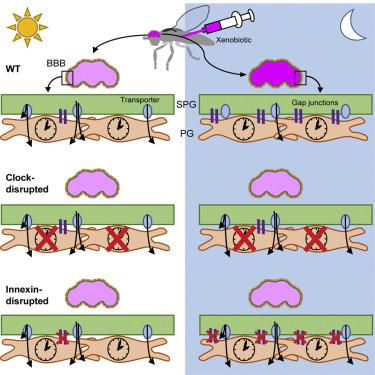Our official English website, www.x-mol.net, welcomes your
feedback! (Note: you will need to create a separate account there.)
A Circadian Clock in the Blood-Brain Barrier Regulates Xenobiotic Efflux.
Cell ( IF 45.5 ) Pub Date : 2018-Mar-22 , DOI: 10.1016/j.cell.2018.02.017 Shirley L Zhang 1 , Zhifeng Yue 2 , Denice M Arnold 2 , Gregory Artiushin 2 , Amita Sehgal 1
Cell ( IF 45.5 ) Pub Date : 2018-Mar-22 , DOI: 10.1016/j.cell.2018.02.017 Shirley L Zhang 1 , Zhifeng Yue 2 , Denice M Arnold 2 , Gregory Artiushin 2 , Amita Sehgal 1
Affiliation

|
Endogenous circadian rhythms are thought to modulate responses to external factors, but mechanisms that confer time-of-day differences in organismal responses to environmental insults/therapeutic treatments are poorly understood. Using a xenobiotic, we find that permeability of the Drosophila "blood"-brain barrier (BBB) is higher at night. The permeability rhythm is driven by circadian regulation of efflux and depends on a molecular clock in the perineurial glia of the BBB, although efflux transporters are restricted to subperineurial glia (SPG). We show that transmission of circadian signals across the layers requires cyclically expressed gap junctions. Specifically, during nighttime, gap junctions reduce intracellular magnesium ([Mg2+]i), a positive regulator of efflux, in SPG. Consistent with lower nighttime efflux, nighttime administration of the anti-epileptic phenytoin is more effective at treating a Drosophila seizure model. These findings identify a novel mechanism of circadian regulation and have therapeutic implications for drugs targeted to the central nervous system.
中文翻译:

血脑屏障中的生物钟调节外来物质的流出。
内源性昼夜节律被认为可以调节对外部因素的反应,但对环境损伤/治疗的有机体反应产生时间差异的机制知之甚少。使用异生物质,我们发现果蝇“血”脑屏障 (BBB) 的通透性在夜间较高。通透性节律由外排的昼夜调节驱动,并取决于 BBB 神经周围神经胶质中的分子时钟,尽管外排转运蛋白仅限于神经周围神经胶质 (SPG)。我们表明,跨层传输昼夜节律信号需要循环表达的间隙连接。具体来说,在夜间,间隙连接会减少细胞内镁([Mg 2+]i) 是 SPG 中外排的正调节剂。与较低的夜间流出一致,抗癫痫苯妥英的夜间给药在治疗果蝇癫痫模型方面更有效。这些发现确定了一种新的昼夜节律调节机制,并对靶向中枢神经系统的药物具有治疗意义。
更新日期:2018-03-09
中文翻译:

血脑屏障中的生物钟调节外来物质的流出。
内源性昼夜节律被认为可以调节对外部因素的反应,但对环境损伤/治疗的有机体反应产生时间差异的机制知之甚少。使用异生物质,我们发现果蝇“血”脑屏障 (BBB) 的通透性在夜间较高。通透性节律由外排的昼夜调节驱动,并取决于 BBB 神经周围神经胶质中的分子时钟,尽管外排转运蛋白仅限于神经周围神经胶质 (SPG)。我们表明,跨层传输昼夜节律信号需要循环表达的间隙连接。具体来说,在夜间,间隙连接会减少细胞内镁([Mg 2+]i) 是 SPG 中外排的正调节剂。与较低的夜间流出一致,抗癫痫苯妥英的夜间给药在治疗果蝇癫痫模型方面更有效。这些发现确定了一种新的昼夜节律调节机制,并对靶向中枢神经系统的药物具有治疗意义。











































 京公网安备 11010802027423号
京公网安备 11010802027423号